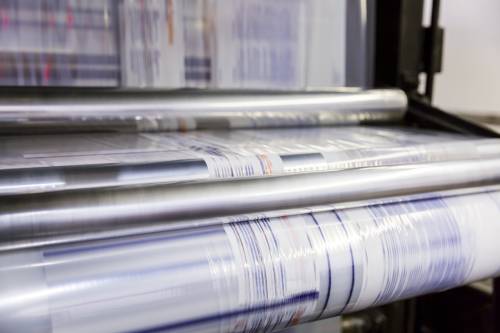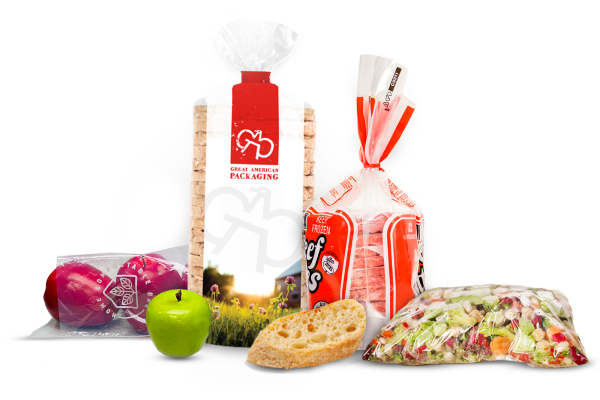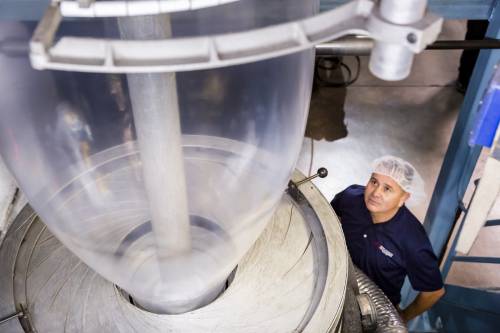
MATERIAL TYPES + COATINGS: FOR CUSTOM BAGS + FILMS
Our expertise in material types and coatings enables us to create packaging solutions for applications across a wide range of industries. Explore the differences between monolayer and multilayer films, and material types to discover their benefits and characteristics.
Flexible Films
POLYETHYLENE

- Excellent moisture barrier characteristics.
- Good clarity.
- High gloss.
- Good tensile strength.
- LDPE and LLDPE (Low Density Polyethylene and Linear Low Density Polyethylene)
- Good clarity.
- Good moisture barriers and fair-gas barriers.
- Heat-seal option.
- Strong and highly flexible.
- LDPE is often selected for its high clarity, ease of processing and high gloss.
- LLDPE is selected for its tensile and impact strength, as well as its heat sealability.
- Common applications: bakery, fresh and frozen food, candy, retail rack display, industrial protection and more.
- High-Density Polyethylene
- Found in many of the same applications as LDPE and LLDPE.
- Down-gauging properties create an economic solution to other polyethylene film types.
- Stiffer than other PE films and better for maintaining shape.
- Strong and puncture resistant.
- Good moisture-barrier properties.
- Resistance to grease and oils.
- Less tear-resistance than other PE films.
- Common applications: cereal and cake mix bags, bakery, shipping sacks and more.
Polypropylene
- Excellent moisture barrier characteristics.
- Good clarity.
- High gloss.
- Good tensile strength.
- High-melting point; ideal for packaging requiring sterilization at high temperatures.
- Average gas-barrier properties.
- Common applications: candy, snack foods, bakery products, cheese, clean room and other sanitary items applications.
boPP (Biaxially Oriented Polypropylene)
- Polypropylene film is extruded and stretched both in and across the machine direction.
- Improved stiffness.
- High tensile strength.
- Excellent optics.
- Good water-vapor barrier properties.
- Can be monolayer or co-extruded structures, and transparent, opaque, or metallized.
- Can be treated with specialty coatings for better sealability and barrier properties.
- Common applications: multilayer barrier films for snacks, pasta and confectionary goods.
PET (Polyethylene Terephthalate)
- Good mechanical properties including toughness and stiffness.
- Good thermal properties withstand higher processing temperatures.
- Polyester product.
- Clear or pigmented options.
- Common applications: multilayer barrier films.
boPET (Biaxially Oriented Polyethylene Terephthalate)
- Polyester film made from stretched PET.
- High-tensile strength.
- Excellent heat resistance.
- Good for microwave or oven use.
- Chemical and dimensional stability.
- High clarity.
- High gas and aroma barrier properties.
- Good electrical insulation.
- Common applications:
- White boPET used as lidding for dairy goods like yogurt.
- Clear boPET used as lidding for fresh or frozen-ready meals.
- Can be metalized for food production to protect against oxidation and for shelf-life expansion.
- Microwave and oven cooking applications.
Nylon
- Relatively high-melting point.
- Good oxygen barrier properties – keeps out oxygen.
- Good off-gassing properties – allows carbon dioxide and other gases to escape.
- Easy to process.
- Common applications: multilayer barrier films for cheese and microwave-cooking applications.
Sustainable Films

Take advantage of consumer demand for sustainable practices and products. Explore our line of sustainable packaging solutions, including compostable, no PFAS added, plant-based and recyclable options.
Monolayer vs. Multilayer
MONOLAYER FILM

Monolayer film is produced with a single film layer typically comprised of LDPE, LLDPE, high density or polypropylene. A metal crimp, twist tie or reclosable feature such as a zipper or tape seals the opening.
Monolayer film is an economical choice when single-layer film properties are sufficient to protect the product from oxygen transfer (OTR), water vapor transfer (WVTR) or other gaseous or greasy substances.
MULTILAYER FILM (Co-Extrusion & Lamination)
Multilayer film joins the best properties of multiple resins into a common structure that performs better than its individual parts. Multilayer film can be co-extruded or laminated.
“Co-extrusion” is when separate extruders are used to produce layers of different polymers. The layers join together in the liquid state just before the extrusion die. The combined layers then pass through the die to be cast or blown into one multilayer film.
“Lamination” adheres multiple film layers together with a bonding agent. Adhesive is applied to the less absorbent layer. A second layer is then pressed against the first to produce a multilayer film. The process is repeated for additional layers.
Film Coatings
PVDC (Polyvinyl Chloride)
- Excellent moisture and gas-barrier properties.
- Grease and oil resistance.
- Common applications: commonly laminated or used as a coating. Known as trade name Saran.™

EVOH (Ethylene Vinyl Alcohol)
- Excellent gas-barrier properties.
- Loses barrier properties when exposed to moisture.
- Holds nitrogen and carbon dioxide inside the package.
- Prevents oxygen transfer inside the package.
- Common applications: typically used in multilayer barrier films. Commonly paired with films like PE with a good moisture barrier. Used in food preservation for foods like fresh pastas where the bag’s atmosphere must remain constant.
MET (Metalized film)
- Micro-thin deposit of aluminum onto poly film, which is vaporized into the film like a coating.
- Highest level of moisture and gas-barrier properties.
- Aluminum coating blocks light, including UV rays that otherwise cause product degradation.
- Common applications: multilayer barrier films. Commonly paired with PET, nylon, oriented polypropylene to dramatically extend perishable products’ shelf life. Paired with polypropylene to resist oxygen, which turns product fat rancid.

